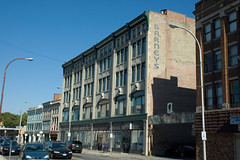Howland Swain Barney was born in Greenfield, Saratoga County, March 23, 1822, to Dr. Zadoc and Eliza Swain Barney. (The Swains were among the original nine families of Nantucket.) His parents moved to Minaville, Montgomery County when he was five. He was schooled there and in 1836 came to Schenectady to work in the dry goods business of Sidney B. Potter. In 1848 he became a partner with John Ohlen & Company; in 1855 he bought an interest in Barringer and Company, buying out his partners in 1858 and establishing the company as H.S. Barney Company.
Cuyler Reynolds, writing in his “Hudson-Mohawk Genealogical and Family Memoirs,” gushes:
“He was a good judge of men and chose his subordinates with rare judgment, rarely making a mistake in his choice of men for certain positions. He rose from the bottom to the topmost rounds of the ladder and each round was gained by active and earnest effort. He was courteous and dignified in manner, somewhat after the style of the olden school. His benevolences were many and were bestowed without ostentation. His acquaintance was very large and he was sincerely honored. His other interests were large.”
The second building to house his store was built in 1872, and expanded again some time later, with substantial changes to its façade. It still stands today. In 1888, its assorted offerings included “full lines of staple and fancy dry goods, hosiery, silks, satins, plushes, blankets, ruchings, napkins, edgings, yarns, antique laces, ladies’ and gents’ furnishing goods, and all kinds of novelties in dress goods, carpets, oil cloths, lace Madras and chenille curtains, shades, etc., and everything appertaining to a first-class carpet room.” Imagine what constituted an “antique lace” in 1888. “The firm make a specialty of fashionable cloak and dress making. All cloaks, dresses and suits are produced after the latest Paris fashions . . . Fifty experienced and efficient assistants and salesladies, etc. are employed, and the trade of the house extends throughout all sections of Schenectady and the adjoining cities.”
Barney also served as a director of Mohawk National Bank, and was active in Republican politics but did not stand for office. He died in 1904.
The store continued for decades, even as Schenectady changed. Slowly the main commercial block moved east of the Erie Canal, to the blocks of State Street above Broadway (once Centre Street). Barney’s former neighbors Kresge’s and Carl Company moved up the street, joined by The Wallace Company, W.T. Grant, and Woolworth’s, leaving Barney’s as the only large department store west of the canal. It survived until 1973, when the spread of malls and suburbanization killed off most of Schenectady’s downtown department stores. Only the Carl Company and Woolworth’s (which wasn’t strictly a Woolworth’s, at least originally) survived, both making it into the 1990s. Barney’s had a very respectable 115-year run.

Image by carljohnson via Flickr


I have a coat from there with a very large white fur collar. It has the Barney’s label on the inside. It is absolutely gorgeous and I wear it out in Schenectady during the very cold winter months, especially if I’m going to Proctor’s or out to eat.
I enjoyed the story. I’m chasing my Grandfather, John F. Horman, who subsequently owned H.S. Barneys. Any info about him, or his wife, Bertha Sconce Horman?
I’m afraid I never did any research on the Hormans. Good name to know about though.